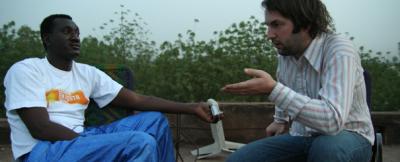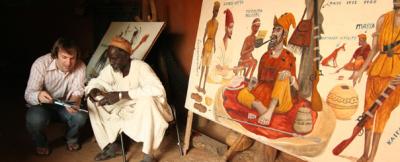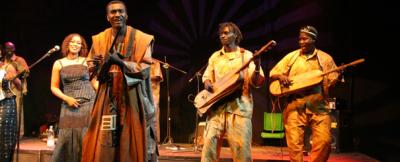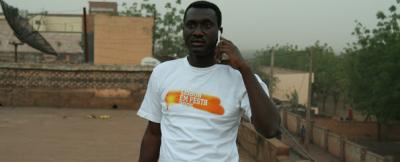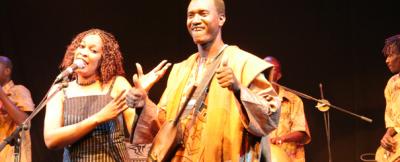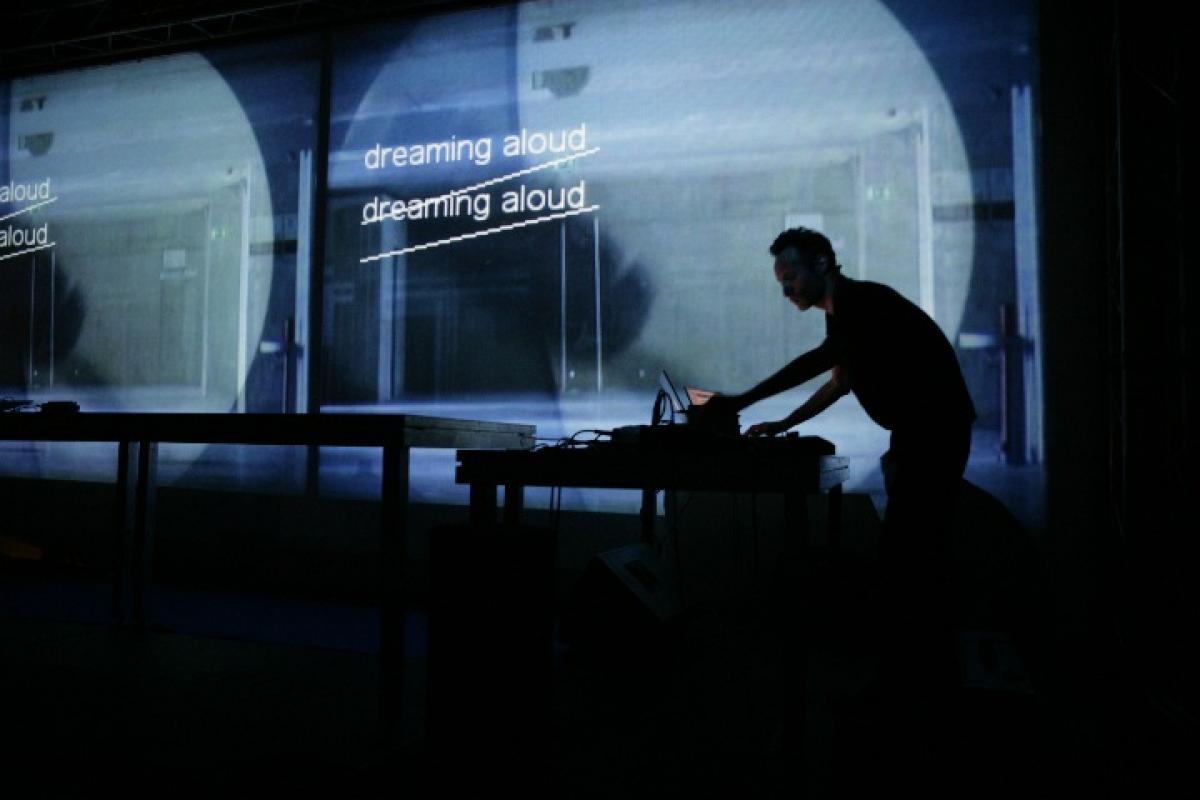
Global Ear on Jerusalem
I think everybody who was around during the very late eighties and early nineties knows this feeling; it’s an exciting feeling – «there’s something good happening in this town. There are people here who are creating something new and intriguing.»
Between, roughly, '88 and '93 the alternative music scene in Jerusalem seemed to supply a consistent flow of interesting acts. First were the alternative groups of '88 - '89. I remember reading about how shocked the Jazz community was when one Friday afternoon in '88, instead of their traditional Friday jam session, two alternative/punk groups, namely Nos’ei Hamigba'at (Top Hat Carriers) and Yisrael, took over the Pargod theater in an energetic show that ended with their own «jam session» – a local version of «Anarchy in the United Kingdom» transformed into «Anarchy in the Judea Kingdom». Being not older than 15 years of age and a metalhead wannabe, I felt these groups might offer me what I always hoped for – a real live band to bang my head to. So we went to see Nosei Hamigba’at play live at this Rock-a-thon lamely titled «Alia Ve’Rock ba». The DJ was constantly playing the new album by some band called The Pixies, and kept saying into the mic: «What, you don’t have the Pixies new album yet?». This is where we first saw 3 Heit, led by their charismatic front man Ran Slavin, who delivered and amazing and noisy show. My friend and I became fans – we spent that year going to every possible 3 Heit concert in Jerusalem, moshing, banging heads and mainly annoying Ran Slavin, who could not figure out what the hell we wanted from him. They were not a metal band at all…
One day, the walls in the center of town were covered with these intriguing posters – a group called Ahat Shtaim Kaze had issued their first tape and were performing their new material. It wasn't really anything organized – just a typically weird Jerusalem mixture of talented yet solipsist bands playing noisy gigs at a Jazz dump and the occasional municipally-planned-concert-for-our-young-local-musicains-accidentally-gone-industrial… Yet, it was enough to jump - start a surge of creativity, that would manifest itself in the coming years in diverse ways, and would grant these groups a respectable status of local mythology. All these bands were now getting great reviews in the newspapers, and Nosei Hamigba’at were starting to get nationwide acclaim. You could feel it – there were things to be excited about. By 1990, this wave of alternative bands from Jerusalem was pretty much over – Nosei Hamigba'at virtually fell apart after their album came out, Ran Slavin moved to Tel Aviv and 3 Heit ceased to exist as a local act while Yisrael were hardly ever performing. By then we were making the noise ourselves, but not without paying our due respects: my first band wanted to play metal like Metallica, but ended up sounding like the worst immitation of Nosei Ha’migba'at you could think of, while another band covered a song by 3 Heit (OK, granted, it did feature one of a 3 Heit member’s younger brother).
1990-93 were definitely the years of metal in Jerusalem. Sepuuku, Leviticus, Senia, Vivid, Incarnation, and the bands that followed would fill the Pargod theater up at any given show. All over the city, hundred of kids were listening to the latest Death or Slayer release, and it was not at all unlikely to be reading a review of Carcass’s new album in the local papers. Death Metal, Doom Metal, Thrash Metal, Grind Core and a very particular style of Jerusalem progressive thrash metal thought of by the locally most influential band, Leviticus – Metal bands were springing up at a surprising rate. Furthermore, these bands (I had the pleasure of playing in a few of them at one point or another) seemed to be offering non-generic brands of crossed-influenced metal, always very original, which became all the more apparent whenever they teamed up with their Tel-Aviv counterparts. You can easily trace the infiltration of that energy into the music of local alternative groups such as Die Welt. But since back then we were all high school kids in a military society, when it was time for us to go to the army, the whole thing gradually dissipated. Within a year or so the whole closed-circle band oriented vibe that characterized Jerusalem faded away. However, a lot of the musicians remained active. Those who could, like Die Welt, followed Nosei Hamigba'at’s footsteps and pursued a major label deal. They were, of course, labeled by the media as «the new and alternative original act from Jerusalem». Others, mainly the veterans were now working in Tel-Aviv under the guise of Kasba records. They were valiant efforts in themselves, but those disparate personal endeavors were not enough to infuse the sensation of a thriving active scene.
That spirit of ‘89 seemed to belong more and more to the realm of the nostalgic than to the present state of the city’s cultural life. It was, however, replaced by a new sense of enthusiasm, of a new form, which would eventually become yet another typical characteristic of Jerusalem’s alternative life. Cultural patterns tend to arrive late in Israel, and often in a derivative form. With the economical changes and information growth spurt the country has undergone during the nineties, paralleled by the infiltration of electronic music and dance culture, people started to spot gaps in Israel’s cultural and musical maps. Since the mid nineties, several groups of young artists from West Jerusalem have attempted to change this situation. It started with the Prozac line of chill-out parties, which evolved into the activities of an action group called Electronic Front. Both were dedicated to the introduction of electronic culture to Israel, and both were based in Jerusalem. The on-location Techno parties thrown by 100 Meter Underground, and the pirate radio station Periscope Radio rehabilitated the cultural underground. These groups were all collectives, small communities, which were involving promoters, artists and other protagonists of electronic music, and were driven by a strong conviction about the desperate need to fill Israel’s cultural void, and each had its very specific agenda, focusing on what they intended to amend. With no real chance of making any profit, most of these groups operated on a purely philanthropic basis.
100 Meter’s efforts proved especially fruitful: Techno eventually became widespread in Israel, and has since infiltrated the big, mainstream clubs, while Jerusalem was crowned the new capital of underground Techno parties. There was a day in October 1999, when Plasticman was playing at Israel’s biggest and most popular club, Ha’Oman 17 in Jerusalem, while at the same time, barely a kilometre away, in an industrial building, a local group of artist called Tzartzar organized a party featuring some of the most exciting local Techno DJs of the time. At that time in ‘99, Techno was probably the most dominant alternative culture phenomena around. Yet it also seemed to be about the only thing we had to do for fun, not counting pubs, movies and stuff like that. 100 Meter Underground supplied their sporadic concentrated doses of one thing only – pure Techno. And frankly, not all of my friends cared much for it . Other forms of alternative activities, or music other than Techno seemed sparse, to the point of hardly existing at all. The electronic (front) music scene was virtually about to collapse, and besides us, who were doing our work at home, I knew there were the guys from Taapet who were doing electronic music, and someone mentioned two other bands – but that was about it. A lot of people our age , including a lot of artists, had then moved or were in the middle of moving to Tel-Aviv. There were no inspiring concerts happening, there was (and still is) a shortage of venues for bands and artists, and so one could have easily believed that there was, in fact, nothing going on at all, that there was nothing noteworthy being created in Jerusalem at the time. Musical life in Jerusalem was looking quite grim and dull.
This was, however, not the case. There were quite a few people who were creating new music, recording either on computers or on eight-tracks, preparing tapes and so on. Of course, they had no way of getting them out of Israel, and no chance of ever being taken seriously by any of Israel’s major labels either, which since the mid-nineties, had been growing ever more enigmatic in their policy towards signing new artists. The musicians could not turn to any non main-stream labels either simply because there weren’t any around at the time, at least none tuned towards Jerusalem. And so they played their music for whoever was willing, and the guy who was working at the local second hand CD store named Balance was a natural candidate, and prepared to listen. Balance was already a sort of centre, a meeting point where people would come in, talk, and sometimes play their stuff. Record stores had always served as a catalytic factor in the development of the local scenes: it was Beit Ha’Taklit which was a natural home for Nos’ei HaMigba’at and their peers, and it was Piccadilli which was the nesting ground for Prozac parties. Fact/Balance as a symbiotic model of a record-store/label was one of those late-arriving cultural phenomena. This close interrelation is sometimes overlooked, but it is the actually the constitutive fact underlying Fact Records’ existence. Yoram’s initial idea was to document works done in a community that was not even aware of itself as such, and to curate these works and present them in their natural habitat. Throughout its existence Fact was a platform upon a platform, and this is the reason why when this symbiosis could not be sustained, the label could not exist any longer. This initial impetus is also the source of Fact’s strongest and at the same time weakest characteristic; at its best, Fact produced a diverse, kicking soundtrack of Israel’s cultural undercurrents. At its worst, the desire to document and represent a wide spectrum of voices, accounts for pre-mature releases could seem like uncritical eclecticism and might even lead to compromises in terms of quality. But, in all fairness, it must be said that there is an ambiguity in the CD-R format that allows such compromises, thus, sometimes, creating them. And it got better with time. When Yoram first contacted us about releasing our material, at the very beginning of 1999, we were working in our studio on our first CD, which was about to be released unconditionally by EG, sending/promising us working with Brian Eno. We released the CD because there was no one else in the country we could turn to. This early image of the label has remained with me for a long time after - a local label, which releases material for the local store as soon as it was presentable. At the time that included us, a metal group named Taapet, a group of near high school kids, a trance act and that crazy Russian guy that was spinning unbearable Hardcore Techno, amongst others. I did not know who most of the other artists were, and I did not care. This was all too peripheral to my taste. I did not have the understanding that was Yoram’s foresight to realize that this was a launching pad, a starting point that had to be met with, from which things would eventually evolve. On top of everything, something of almost mystical proportions had to be encountered – Jerusalem’s highly reclusive mentality. There was no chance that these works would ever see the light of day if they couldn’t be lured out by someone. I was not aware that after twenty releases out on its first year, Fact would become more than an un-involved local CD-R label. That a year down the road it would cover a whole country. That eventually Fact would bring disparate artists together into a sort of community. I was also not aware of the double role Yisrael played in this story. It was a talk with Nevo of Yisrael which eventually influenced Yoram to form a CD-R label, a concept unheard of in the country until then. «Listen, just print it!» was pretty much the core message that helped resolve Yoram’s personal debate on the hows and whats of putting releases out. Furthermore, it was after he heard Yisrael’s 1989 forgotten recordings of the album Jehova, which effectively fused Punk, Hip-Hop and Industrial influences with subversive calls for total change in consciousness (termed «The Yisareli Revolution»), which sparked and instigated Fact’s second impetus – to reissue older, out of print recordings of non-mainstream Israeli music. Jehova seemed like a real radical piece to come out in this country at the time. Granted, the people involved were militants, yet they were on a par with the Avant-garde world of their time. Jehova was labeled Fact001, so as to symbolize their heritage . But this aspect of the label, this link to the past, did not become fully obvious for two more years, until the re-release of Plastic Venus’s 1991 self-titled debut, arguably the first Noise album in Israel.
The event that celebrated the Plastic Venus release is emblematic of Fact’s role as a unifying factor. The event was opened by a DJ set by Shuffle, who came from a newly formed label in Jerusalem, playing versatile brands of alternative music. He was followed by Charlie Megira And The Lawless Girl, whose dreamy tributes to guitar-based pop ballads deconstructs Israel musical history by acknowledging the existence of an early Rock ’n’ Roll culture in Israel in the fifties, and thereby pointing to an alternative to the army’s ubiquitous military bands. The highlight was delivered by an outfit which was probably the apex of Tel Aviv’s thriving Alt Rock scene in the late eighties. The crowd featured pretty much everybody involved with any local non-mainstream movement – from Hip Hop to Avant-garde. Through Fact’s subsequent involvement in events like this one, the Fact birthday parties and other, different local initiatives, people gradually got to know each other, connections were formed between individuals and groups of artists. From the first year onwards one could observe how the label’s impact was growing ever more steadily. With time, specific stylistic divisions had evolved inside the label’s catalogue. They gradually became clearer: Electronic, Rock in Hebrew, Rock in English, re-issues. Fact developed its own character. People felt they were participating in something unique. Gradually, the artists involved with the label were getting more familial with one another, thus they over time developed into communities. It took a while until it got picked up, whether by national media, or by wider alternative music crowd. None of the albums ever crossed into sales of thousands. Over Fact’s third year, through my work at Hazira, I met many of the artists, including my undisputed favourite, Gelbart, whose intelligent, playful music, with its off hand wink at Avant-garde, is more captivating than that of a whole lot of well known electronic artists. It became apparent there is something in this label that strikes a chord in many hearts, that the artistic standards are constantly rising.
During Fact’s third birthday, in August 2002, I met a guy called Adam, he was from another local label called Men of Israel, and at the time when I met him he was sitting with his own label stand next to the Fact stand. A few months later, a couple more labels sprung up. At one point, we counted nine labels. Miklataklitim.com, Ak-Duck, Nine Records, Shoshana, Interval (Micropeople), and Woolwung all acknowledge the role of Fact, which was pioneering, and showing the way. Ido Govrin of Interval simply says «Fact for sure played a role in my development just because it was there, with all the activities and all... as a playground for local Jerusalem artists...» «Our vision is different», says sc dispara! of miklataklitim.com, «but Yoram showed how things could be done. I saw it and said, ‹Hey, I can also do back covers and burn CDs›». Itamar Weiner and Harel Schreiber started their own label Ak Duck, which focuses on electro, after Yoram rejected their CD. «He paved the way for us», says Weiner. «Fact has a good and caring system, but it leaves out the genre we like. So we can do something along the same lines, only with music we like.» All these people were cutting their own CDs. It became evident that part of the Fact ethos had infiltrated people’s lives – you can do it yourself. But it was more than that…Looking around, reading the manifestos by the labels, seeing what was happening, listening to Coma, Galbart, Yappim…All of a sudden one could feel it again…There is something new, interesting, cool, happening, and it’s happening here. There it was again – that spirit I felt in ‘89. There are people around who are doing really exciting stuff, and this time – they’re together, aware of each other, reversing the values, placing creativity over impression and status.
Biography
Published on December 09, 2006
Last updated on August 10, 2020
Topics
From Bangladeshi electronica to global «black midi» micro scenes.
Music and art that dealing with the unfinished and undefined.
Place remains important. Either for traditional minorities such as the Chinese Lisu or hyper-connected techno producers.
Snap


